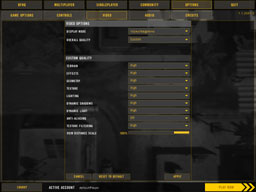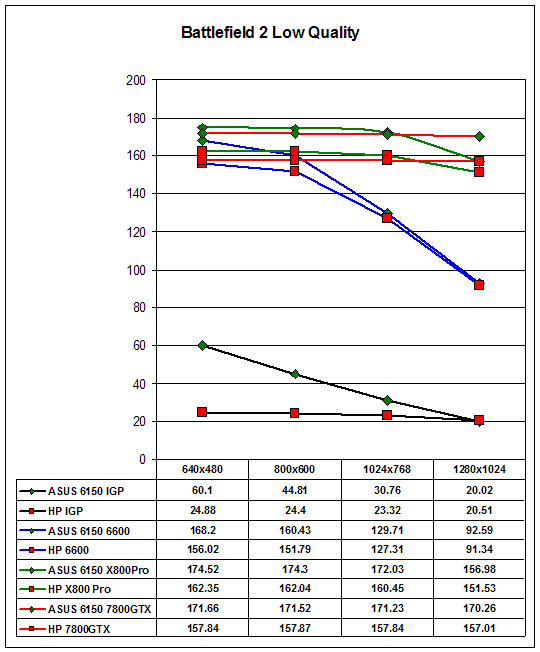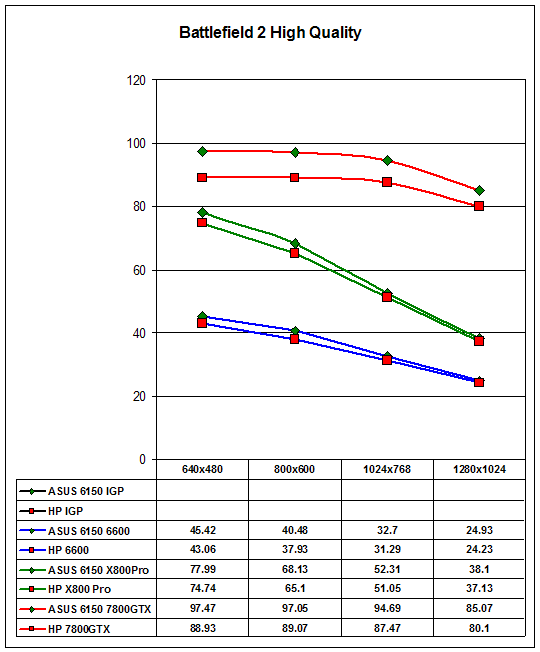Gaming Benchmarks - Battlefield 2
For our gaming benchmarks, we ran the systems in two different modes: a lower quality mode that allowed the IGPs to get relatively playable frame rates, and a higher quality mode that was a more realistic setting for the discrete graphics cards. Most of the discrete graphics cards will be system/CPU limited in the low quality mode, but that information can be interesting as well. Obviously, the IGP solutions really aren't intended for serious gamers, but we wanted to see if they could still provide a playable gaming experience with lower detail settings.
The above screenshots show the settings that we used in Battlefield 2. Our low quality BF2 configuration uses the "Low" preset, with texture quality also downgraded to low. Anisotropic filtering and antialiasing are disabled, and we tested at 640x480, 800x600, 1024x768, and 1280x1024. (We don't consider 640x480 playable in BF2, as the text is unreadable, but it was included for reference.) The higher quality mode uses the "High" preset, with textures also set to high. Antialiasing is disabled, and anisotropic filtering is set to 8x. The 7800 GTX generally wouldn't have a problem with 4xAA on the tested resolutions, but realistically, we don't expect users to put a 7800 GTX in this type of system.
While the integrated graphics solutions struggle to maintain playable frame rates even at the lowest resolutions, sticking with low detail levels and switching to even a 6600 provides very good results. In fact, the 6600 is capable of running very well in the medium quality modes while still maintaining reasonable frame rates. With the more powerful graphics cards, we can see that the faster memory and lower latencies provided on our custom system end up winning out - even with the slower processor. The 3800+ Venice core is limited to 171 FPS, while the HP system is limited to 157 FPS.
Moving onto the higher-quality mode, the IGP solutions are way too slow. Both systems were providing single digit frame rates, so we halted benchmarking rather than waiting for each test to complete. With the other graphics cards, the custom system ends up leading by as much as 9%, but you really wouldn't notice the difference in practical use. It appears that the improved memory controller and cache subsystem on the Venice core makes up for the lack of cache relative to the ClawHammer core. At that point, the lower latency RAM takes the lead.
For our gaming benchmarks, we ran the systems in two different modes: a lower quality mode that allowed the IGPs to get relatively playable frame rates, and a higher quality mode that was a more realistic setting for the discrete graphics cards. Most of the discrete graphics cards will be system/CPU limited in the low quality mode, but that information can be interesting as well. Obviously, the IGP solutions really aren't intended for serious gamers, but we wanted to see if they could still provide a playable gaming experience with lower detail settings.
 |
 |
| Click on images to enlarge. | |
The above screenshots show the settings that we used in Battlefield 2. Our low quality BF2 configuration uses the "Low" preset, with texture quality also downgraded to low. Anisotropic filtering and antialiasing are disabled, and we tested at 640x480, 800x600, 1024x768, and 1280x1024. (We don't consider 640x480 playable in BF2, as the text is unreadable, but it was included for reference.) The higher quality mode uses the "High" preset, with textures also set to high. Antialiasing is disabled, and anisotropic filtering is set to 8x. The 7800 GTX generally wouldn't have a problem with 4xAA on the tested resolutions, but realistically, we don't expect users to put a 7800 GTX in this type of system.


While the integrated graphics solutions struggle to maintain playable frame rates even at the lowest resolutions, sticking with low detail levels and switching to even a 6600 provides very good results. In fact, the 6600 is capable of running very well in the medium quality modes while still maintaining reasonable frame rates. With the more powerful graphics cards, we can see that the faster memory and lower latencies provided on our custom system end up winning out - even with the slower processor. The 3800+ Venice core is limited to 171 FPS, while the HP system is limited to 157 FPS.
Moving onto the higher-quality mode, the IGP solutions are way too slow. Both systems were providing single digit frame rates, so we halted benchmarking rather than waiting for each test to complete. With the other graphics cards, the custom system ends up leading by as much as 9%, but you really wouldn't notice the difference in practical use. It appears that the improved memory controller and cache subsystem on the Venice core makes up for the lack of cache relative to the ClawHammer core. At that point, the lower latency RAM takes the lead.










48 Comments
View All Comments
JarredWalton - Monday, December 19, 2005 - link
I understand, though I would never want to actually reach the point where I was running a PSU at maximum output power. I personally like to think of the input power as a buffer: if your input Watts exceed the rating of a PSU, you're treading on dangerous ground (IMO).Cygni - Thursday, December 15, 2005 - link
Im loving the variety of reviews coming out of anandtech recently. When there isnt much new stuff coming out (like right now), its great to have something from a totally different angle to read and chew on, like this review. The addition of the add on graphics board and 6150 comparison system was a great touch, and really helped me think about my needs for my next box.All in all, some may not enjoy this article because it isnt a 500 card 7800GTX reference design roundup (which nobody reading can afford anyway), but i certainly think it was a good touch... if for nothing else than "Hey, lets look how an upper-mid level system from a builder performs versus a homebuilt" or "Lets look at true integrated graphics performance."
Sunrise089 - Thursday, December 15, 2005 - link
...but this article has given me more info about graphics performance than many recent video card write-ups here. You actually tested at a variety of setttings and on hardware that didn't incllde an FX-57. I know the cards may be CPU limited, but so what. I now know that I can build someone an office computer and tell them that if they add a $100 6600 they can play some pretty nice games at 60+ FPS at decent quality, something the FX-57 with all settings on 'high' articles wouldn't tell me. Please keep this trend up, and feel free to work in the other direction as well - higher levels of AA and AF and Image Quality tests.Sunrise089 - Thursday, December 15, 2005 - link
Jarred - You and Anand continue to be my favorite writers here at AT. I really like the intro to this article, especially the background you provide. By letting us know your out-of-AT existance it makes it easier to understand why you are reviewing this particular part and how it is not an example of AT "selling out". I think this is a great example of how the internet era allows a much closer relationship between the content providers (you editors and writers) and the users (us) that can help us identify with your perspective on hardware. I strongly support this type of intro for the other writers here - let us know who you are and what you do, so we can view your opinions in the framework of your actual life.JarredWalton - Thursday, December 15, 2005 - link
Thanks, Sunrise! :)I do my best to keep the readers happy. The extra benchmarks on this are really somewhat extraneous to the actual review, but I hope a lot of people found the numbers useful.
kilkennycat - Thursday, December 15, 2005 - link
Jarred, I suggest correcting the last paragraph ASAP.Why AMD decided in their (er) wisdom to use the same base number for the 2 different parts beats me.
JarredWalton - Thursday, December 15, 2005 - link
I have a direct from an HP representative that the linked SKU is in fact an X2 3800+. Here is a direct quote from the e-mail I received:"We actually have an X2 3800+ Smart Buy, sku # pz635ua#aba....it might be
listed incorrectly as a 3800+, but it's an X2. I'm in the process of
getting that fixed."
Obviously, that needs to be corrected, but for now I'll trust the management of the small-business division. :-)
Furen - Thursday, December 15, 2005 - link
AMD did not want to release an X2 3800+, if you remember. People bitched and moaned about the X2s being expensive so the 3800+ was released.Paratus - Wednesday, December 14, 2005 - link
We've got HPs at work and I'm generally happy with it for a work computer. The LCDs are fine the chip was a P43.2 which was a nice step up from a 2.2 P4. Only main issues was the lack of dual channel ram (512mb only)phaxmohdem - Wednesday, December 14, 2005 - link
Yeah, unfortunatly for some reason, corporate buyers seem to think that RAM is the least of their worries when purchasing. Faster CPU's and stuff are nice, but if you don't give it the memory to play with whats the point? A PIII 1GHz machine with 1GB of ram is still hella fast for any standard white-shirt business task.I simply don't understand it, its a relatively inexpensive upgrade but businesses just don't go for it. Whatever, I'm sure they have a good reason.